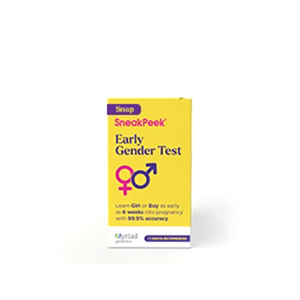Published on November 14th, 2023 and Updated on February 29th, 2024
Check out SneakPeek Gender Test to find out your baby’s gender as early as 6 weeks at over 99% accuracy1!
From the silhouette of your baby bump to the type of pregnancy cravings you’re having, a laundry list of gender prediction tactics can (supposedly) introduce you to your little bundle earlier than your due date. The baking soda gender test is one of them—it’s a simple process that assesses the reactivity of your urine sample to one simple ingredient: baking soda.
Supposedly, the chemical reaction that ensues can tell you whether your future arrival is a boy or a girl. But how reliable is it really when it comes down to predicting gender?
When it comes down to the scientific evidence, it’s not reliable. That said, it can add a healthy dose of fun and fantasy to your pregnancy.
If you’re keen to learn your baby’s sex sooner rather than later to help prevent gender disappointment, we’ll provide the most accurate ways to find out below. Plus, we’ll put the baking soda gender test to the test to see if there’s any wisdom it has to impart about prenatal health and wellness.
What’s the baking soda gender test?
Reminiscent of volcanoes from your middle school science fair, the baking soda gender test is a gender prediction experiment of the old wives’ tale variety that involves two key variables:
- Sodium bicarbonate (also known as baking soda)
- Your urine
To take the test, you’ll need a small, disposable container for the baking soda, a cup for your urine, and the call of nature. Performing the fizzy experiment only requires a few simple steps:
- Prep your ingredients – Choose a cup you don’t feel strongly about and put a tablespoon or two of baking soda inside.
- Wash your hands – This minimizes the chances that extra pollutants will muddy the results of your experiment.
- Head to the bathroom – When you need to pee, position your urine cup in line with your urine stream and take a small sample.
- Wash your hands again – For the sake of hygiene, clean yourself of any urine that’s missed the cup.
- Mix baking soda and pee – Remaining in your bathroom, pour approximately 1 to 2 tablespoons of urine—as equal a ratio as possible—into the cup containing baking soda.
According to this old wives tale, the more reactive your urine is to the baking soda, the more likely it is that your baby will be a boy. If the mixture’s reaction is mild (or shows no signs of volcanic activity at all) you can expect to have a girl.
This “test” has no requirements with respect to how far along you need to be in your pregnancy. Supposedly, it can be performed at any point along the way. However, you may notice more potent or accurate results if you take the test soon after waking up, since urine tends to be diluted throughout the day as you ingest fluids.
Baking Soda Gender Test: Accuracy and Risks
Unfortunately, just like many wives tales, such as the ring gender test, there’s no scientific evidence to suggest the baking soda test carries any weight when it comes to predicting your baby’s gender.
But are there any risks or downsides to trying it out? Nope!
Baking soda is a relatively benign substance that’s safe to manually handle during pregnancy, whether to take the test or to perform daily tasks like household cleaning. Neither you nor your growing baby will be put in harm’s way by taking the test. So if you’re curious to give it a try, go for it!
Does urine acidity have anything to do with a baby’s gender?
There’s no concrete evidence of a link between the acidity of your urine and the sex of your baby.
That said, pH can be a telling variable for other areas of your health and pregnancy. On average, urine pH weighs in at around 6.0—slightly more acidic than a neutral pH (neutral is considered 7.0). However, healthy urine can land anywhere between 4.5 (more acidic) to 8.0 pH (more alkaline or basic). Sometimes, taking certain medications can make your urine more acidic.
The Takeaway: The Importance of pH Levels During Pregnancy
While your urine’s pH value can’t tell you your baby’s gender, vaginal pH can be an important marker of health during pregnancy.
When your vagina is healthy, its pH tends to be more acidic: between 3.8 and 4.2 pH. A slightly acidic pH is one way your vagina keeps its microbiome—an internal ecosystem of bacteria, chiefly lactobacilli—remaining in balance. When that balance is disrupted and becomes more alkaline, it can put you at risk of developing infections like bacterial vaginosis (BV).
BV is very common among pregnant women. Around 1 million expecting moms develop it every year. While the infection is highly responsive to treatment through antibiotic medication, undiagnosed or untreated BV can heighten an expecting mom’s risk of:
- Contracting other infections (especially STIs)
- Pregnancy complications
With that, maintaining a healthy vaginal pH is an important part of a healthy pregnancy. If you have BV, you may notice a strange or foul-smelling discharge—but between 50 and 75% of BV cases don’t present with any symptoms.
Making a point to stick to your prenatal appointment schedule is one of your best lines of defense against BV. Seeing your OBGYN or primary care provider regularly can help ensure you catch any infection early, get treated, and protect both maternal and fetal health.
The Biology Behind Sex: What decides your baby’s sex?
A baby’s biological sex, much like old wives’ tale methods of gender prediction, is largely a gamble.
Biological sex is determined by sex chromosomes, which are one pair of chromosomes among the 23 present at conception (the other 22 are known as autosomes):
- Two XX chromosomes indicate a baby will be female
- One X and one Y chromosome means a baby will be male
Following conception, several genetic, biological, and hormonal processes must carry through in order to cement a baby’s sex. For instance, in utero, a fetus’ sex organs don’t become noticeably male or female until around the 9-week mark.
Until recently, the ultrasound was one of the most accurate and earliest ways to determine a baby’s gender. To confirm a fetus’ gender, their sex organs had to be legible on a monitor.
However, recent developments in genetics testing have made it possible for expecting moms, parents, and their families to discover their baby’s gender well before those anatomical differences are made apparent.
The Most Accurate Ways to Predict Your Baby’s Gender
Technology has advanced enough that we don’t have to rely on homespun methods for predicting a baby’s sex (though they can certainly be fun!).
If you’re anxious to learn your baby’s biological sex, any of the following methods may be used to greet your newest family member sooner rather than later:
- At-home tests – At-home blood tests are a form of noninvasive prenatal testing (NIPT) that screen for Y chromosomes in your bloodwork. These highly accurate tests can be taken conveniently (and virtually painlessly) at home and sent to certified labs for review. (Psst—SneakPeek’s Early Gender Blood Test can reveal your baby’s sex with over 99% clinical accuracy1 as soon as 6 weeks into your pregnancy.)
- Ultrasound – Traditionally, expecting moms learned their baby’s sex during their second ultrasound, typically offered between 18 and 22 weeks of pregnancy. Ultrasounds also provide an anatomy scan of your baby in utero to verify your baby is developmentally healthy.
- Chorionic villus sampling (CVS) – CVS is typically administered between 10 and 13 weeks of pregnancy. It’s primarily used to screen for genetic or chromosomal anomalies that could cause disorders like Down syndrome, though it may also be used to test for fetal sex. Considered a more invasive form of testing, it requires a needle to be inserted into your placenta to retrieve tissue for testing.
- Amniocentesis – Amniocentesis is typically administered between 15 to 20 weeks of pregnancy. Like CVS, it’s considered more invasive than an at-home gender prediction test or an ultrasound. The procedure scans your amniotic fluid to detect genetic, chromosomal, or developmental abnormalities; it can also be used to confirm a baby’s sex.
While the aforementioned methods are far more reliable when it comes to gender prediction, there’s no reason why you shouldn’t explore heirloom approaches if they pique your interest. If there’s any life transition that connotes the idea of “practical magic,” it’s pregnancy—and there’s no reason why your journey can’t be as enchanted as it is informed.
Discover Your Baby’s Gender Early with SneakPeek
If you’re as few as 6 weeks along into your pregnancy, you can put your baking soda gender prediction test results to the SneakPeek test. SneakPeek’s Early Gender DNA Blood Test can tell you your future baby’s sex earlier than your first ultrasound with over 99% clinically proven accuracy1 and DNA-based results.
The process is simpler (and less messy) than the baking soda approach: You’ll take your sample at home, mail it to SneakPeek labs, and we’ll triple-review your results and return them on the same day they’re received. We’ll even send you a complimentary downloadable report you can share with your healthcare provider for review.
More than 1 million moms trust SneakPeek to share the news of their future arrival’s gender. Find out why SneakPeek is the #1-recommended at-home early gender test today.
This post has been reviewed for accuracy by:
Sarah Cacia, currently leading as the Director of Business Development at Gateway Genomics, parent company of SneakPeek, brings an impressive blend of bioengineering expertise and clinical business acumen. Her extensive experience, marked by roles at renowned institutions like Genentech and UC San Diego's Cardiac Mechanics Research Group, underpins her deep understanding of biotechnology and clinical research. A UC San Diego alumna with a Bachelor of Science in Bioengineering: BioSystems, Sarah's rich professional background empowers her to provide authoritative insights into the cutting-edge developments in the field.
Sources:
- Greatist. Can the Baking Soda Gender Test Tell What Kind of Bun’s in the Oven? https://greatist.com/health/baking-soda-gender-test
- Allo Health. Using Baking Soda During Pregnancy: Benefits and Risks. https://www.allohealth.care/healthfeed/pregnancy/baking-soda-pregnancy
- Healthline. Urine pH Level Test. https://www.healthline.com/health/urine-ph
- Healthline. Everything You Need to Know About Your Vaginal pH Balance. https://www.healthline.com/health/womens-health/vaginal-ph-balance
- Healthline. Infections in Pregnancy: Bacterial Vaginosis. https://www.healthline.com/health/pregnancy/infections-bacterial-vaginosis
- Britannica. Sex chromosome. https://www.britannica.com/science/sex-chromosome
- Science Daily. Geneticists make new discovery about how a baby’s sex is determined. https://www.sciencedaily.com/releases/2018/12/181215141333.htm
- Baby Center. When do your baby’s sex organs develop in the womb? https://www.babycenter.com/pregnancy/your-baby/fetal-development-your-babys-genitals-and-urinary-system_40005752
- Medical News Today. How early can people find out the sex of a baby? https://www.medicalnewstoday.com/articles/when-can-you-find-out-the-sex-of-a-baby#methods
- Cleveland Clinic. Chorionic Villus Sampling for Prenatal Diagnosis. https://my.clevelandclinic.org/health/diagnostics/4028-chorionic-villus-sampling-for-prenatal-diagnosis
- Johns Hopkins Medicine. Amniocentesis. https://www.hopkinsmedicine.org/health/treatment-tests-and-therapies/amniocentesis

Shop Our Products
SneakPeek aims to provide the most accurate and up-to-date information to help our readers make informed decisions regarding their health before, during, and after pregnancy. This article was written based upon trusted scientific research studies and/or articles. Credible information sources for this article are cited and hyperlinked.






